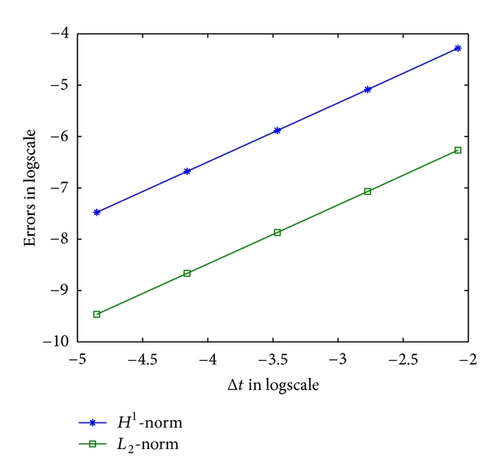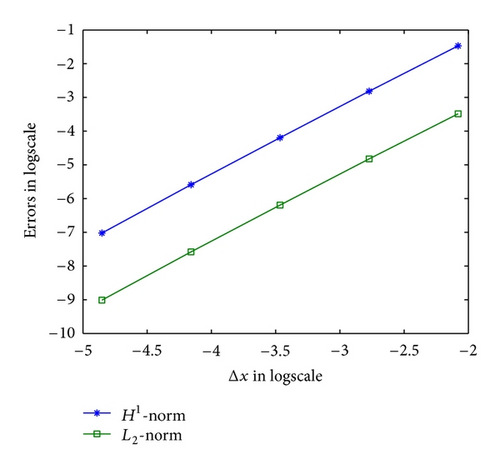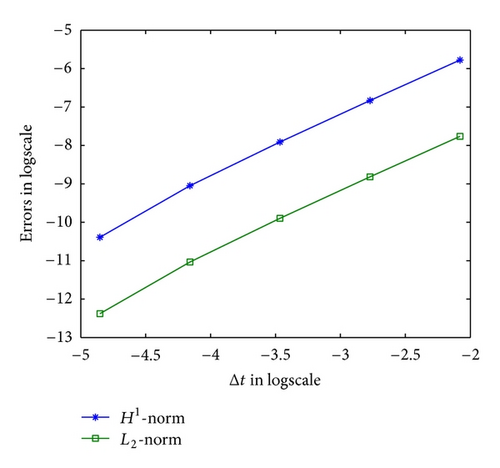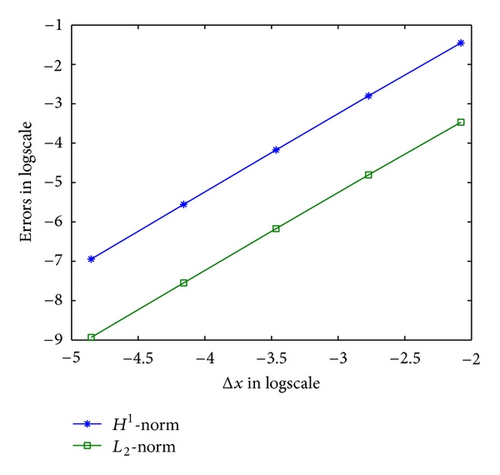Stability and Convergence of an Effective Finite Element Method for Multiterm Fractional Partial Differential Equations
Abstract
A finite element method (FEM) for multiterm fractional partial differential equations (MT-FPDEs) is studied for obtaining a numerical solution effectively. The weak formulation for MT-FPDEs and the existence and uniqueness of the weak solutions are obtained by the well-known Lax-Milgram theorem. The Diethelm fractional backward difference method (DFBDM), based on quadrature for the time discretization, and FEM for the spatial discretization have been applied to MT-FPDEs. The stability and convergence for numerical methods are discussed. The numerical examples are given to match well with the main conclusions.
1. Introduction
In recent years, the numerical treatment and supporting analysis of fractional order differential equations has become an important research topic that offers great potential. The FEMs for fractional partial differential equations have been studied by many authors (see [1–3]). All of these papers only considered single-term fractional equations, where they only had one fractional differential operator. In this paper, we consider the MT-FPDEs, which include more than one fractional derivative. Some authors also considered solving linear problems with multiterm fractional derivatives (see [4, 5]). This motivates us to consider their effective numerical solutions for such MT-FPDEs, which have been proposed in [6, 7].
The paper is organized as follows. In Section 2, the weak formulation of the MT-FPDEs is given and the existence and uniqueness results for such problems are proved. In Section 3, we consider the convergence rate of time discretization of MT-FPDEs, based on the Diethelm fractional backward difference method (DFBDM). In Section 4, we propose an FEM based on the weak formulation and carry out the error analysis. In Section 5, the stability of this method is proven. Finally, the numerical examples are considered for matching well with the main conclusions.
2. Existence and Uniqueness
- (i)
The left Caputo derivatives:
() - (ii)
The left Riemann-Liouville derivatives:
() - (iii)
The right Riemann-Liouville derivatives:
()
From [3], for σ > 0, σ ≠ n − 1/2, the spaces , , and are equal, and their seminorms are all equivalent to . We first recall the following results.
Lemma 1 (see [3].)Let 0 < θ < 2, θ ≠ 1. Then for any , then
Based on the main results in Subsection 3.2 in [32], we can prove the following existence and uniqueness theorem.
Theorem 2. Assume that 0 < α < 1 and . Then the system (17) has a unique solution in Bα/2(I × Ω). Furthermore,
Proof. The existence and uniqueness of the solution of (17) is guaranteed by the well-known Lax-Milgram theorem. The continuity of the bilinear form 𝒜 and the functional ℱ is obvious. Now we need to prove the coercivity of 𝒜 in the space Bα/2(I × Ω). From the equivalence of , and , for all u, v ∈ Bα/2(I × Ω), using the similar proof process in [32], we obtain
3. Time Discretization and Convergence
Lemma 3 (see [34].)For 0 < α < 1, let the sequence {dj} j=1,2,… be given by d1 = 1 and . Then, 1 ≤ dj ≤ (sin (πα)/πα(1 − α))jα, for j = 1,2, 3, ….
Let ej = u(tj) − Uj denote the error in tj. Then we have the following error estimate.
Theorem 4. Let Uj and u(tj) be the solutions of (27) and (21), respectively. Then one has ∥Uj − u(tj)∥≲Δt2−α.
Proof. Subtracting (27) from (26), we obtain the error equation
Note that e0 = u(0) − U0 = 0. Denote
Note that A is a positive definite elliptic operator with all of eigenvalues λ > 0. Since and Γ(−α) < 0, we have
Denote d1 = 1 and
4. Space Discretization and Convergence
Let Rh : H1(Ω) → Sh be the elliptic projection, defined by , for all χ ∈ Sh.
In virtue of the standard error estimate for the FEM of MT-FPDEs, one has the following theorem which can be proved easily by Lemma 5 and the similar proof in [35].
5. Stability of the Numerical Method
In this section, we analyze the stability of the FEM for MT-FPEDs (1)–(3). Now we do some preparations before proving the stability of the method. Based on the definition of coefficients in Section 3, we can obtain the following lemma easily.
Lemma 7. For 0 < α < 1, the coefficients , (k = 1, …, j) satisfy the following properties:
- (i)
and for k = 1,2, …, j,
- (ii)
.
Now we report the stability theorem of this FEM for MT-FPDEs in this section as follows.
Theorem 8. The FEM defined as in (38) is unconditionally stable.
Proof. In (38), let χ(·) = Uj(·) at t = tj and the right hand . We have
Using, Cauchy-Schwarz inequality, for k = 0,1, 2, …, N and Lemma 7, we get
We prove the stability of (37) by induction. Since when j = 1, we have
Here 0 < 1 − α < 1. After squaring at both sides of the above inequality, we obtain .
6. Numerical Experiments
In this section, we present the numerical examples of MT-FPDEs to demonstrate the effectiveness of our theoretical analysis. The main purpose is to check the convergence behavior of numerical solutions with respect to Δt and Δx, which have been shown in Theorem 4 and Theorem 6. It is noted that the method in [29] is a special case of the method in our paper for fractional partial differential equation with single fractional order. So, we just need to compare FEM in our paper with other existing methods in [8, 28].
Example 9. For t ∈ [0, T], x ∈ (0,1), consider the MT-FPDEs with two variables as follows:
We use this example to check the convergence rate (c. rate) and CPU time (CPUT) of numerical solutions with respect to the fractional orders α and β.
In the first test, we fix T = 1, α = 0.9 and β = 0.5 and choose Δx = 0.001 which is small enough such that the space discretization errors are negligible as compared with the time errors. Choosing Δt = 1/2i (i = 2,4, …, 7), we report that the convergence rate of FDM in time is nearly 1.15 in Table 1, which matches well with the result of Theorem 4. On the other hand, Table 2 shows that an approximate convergence rate is 2, by fixing Δt = 0.001 and choosing Δx = 1/2i (i = 2, …, 6), which matches well with the result of Theorem 6. In the second test, we give the convergence rate when α = 0.5, β = 0.25 for Δt in Table 3, and Δx in Table 4, respectively. We also report the L2-norm and H1-norm of errors in Figures 1 and 2, respectively.
Fixing Δx = 0.001, α = 0.9, and β = 0.3 in (46), we compare the error and CPUT calculated by the FEM in this paper with the FDM in [8] and the FPCM in [8]. From Table 5, it can be seen that the FEM in this paper is computationally effective.
| Δx | Δt | H1-norm | L2-norm | c. rate | CPUT (seconds) |
|---|---|---|---|---|---|
| 0.001 | 1/4 | 1.3815 × 10−2 | 1.8960 × 10−3 | 0.214 | |
| 0.001 | 1/16 | 6.1890 × 10−3 | 8.4939 × 10−4 | 1.1585 | 0.357 |
| 0.001 | 1/32 | 2.7858 × 10−3 | 3.8234 × 10−4 | 1.1516 | 0.736 |
| 0.001 | 1/64 | 1.2571 × 10−3 | 1.7252 × 10−4 | 1.1481 | 1.438 |
| 0.001 | 1/128 | 5.6567 × 10−4 | 7.7635 × 10−5 | 1.1520 | 2.922 |
| Δt | Δx | H1-norm | L2-norm | c. rate | CPUT (seconds) |
|---|---|---|---|---|---|
| 0.001 | 1/4 | 0.2294 | 3.0611 × 10−2 | 20.35 | |
| 0.001 | 1/16 | 5.9763 × 10−2 | 8.0381 × 10−3 | 1.9291 | 21.85 |
| 0.001 | 1/32 | 1.5067 × 10−2 | 2.0442 × 10−3 | 1.9753 | 26.68 |
| 0.001 | 1/64 | 3.7356 × 10−3 | 5.0966 × 10−4 | 2.0039 | 32.72 |
| 0.001 | 1/128 | 8.9129 × 10−4 | 1.2198 × 10−4 | 2.0629 | 41.03 |
| Δx | Δt | H1-norm | L2-norm | c. rate | CPUT (seconds) |
|---|---|---|---|---|---|
| 0.001 | 1/4 | 3.0985 × 10−3 | 4.2525 × 10−4 | 0.218 | |
| 0.001 | 1/16 | 1.0789 × 10−3 | 1.4807 × 10−4 | 1.5221 | 0.413 |
| 0.001 | 1/32 | 3.6702 × 10−4 | 5.0372 × 10−5 | 1.5556 | 0.921 |
| 0.001 | 1/64 | 1.1772 × 10−4 | 1.6156 × 10−5 | 1.6406 | 1.855 |
| 0.001 | 1/128 | 3.0704 × 10−5 | 4.2139 × 10−6 | 1.6388 | 3.783 |
| Δt | Δx | H1-norm | L2-norm | c. rate | CPUT (seconds) |
|---|---|---|---|---|---|
| 0.001 | 1/4 | 2.3325 × 10−1 | 3.1119 × 10−2 | 23.73 | |
| 0.001 | 1/16 | 6.0836 × 10−2 | 8.1823 × 10−3 | 1.9272 | 26.29 |
| 0.001 | 1/32 | 1.5382 × 10−2 | 2.0870 × 10−3 | 1.9711 | 33.49 |
| 0.001 | 1/64 | 3.8569 × 10−3 | 5.2622 × 10−4 | 1.9877 | 41.68 |
| 0.001 | 1/128 | 9.6378 × 10−4 | 1.3189 × 10−4 | 1.9963 | 55.24 |
| Δx | Δt | FEM | FDM [8] | FPCM [8] | |||
|---|---|---|---|---|---|---|---|
| Error | CPUT | Error | CPUT | Error | CPUT | ||
| 0.001 | 1/4 | 3.7056 × 10−3 | 0.238 | 5.8723 × 10−3 | 0.897 | 2.2027 × 10−2 | 6.16 |
| 0.001 | 1/8 | 1.6794 × 10−3 | 0.481 | 2.6751 × 10−3 | 1.837 | 8.7467 × 10−3 | 16.63 |
| 0.001 | 1/16 | 7.6528 × 10−4 | 0.962 | 1.2159 × 10−3 | 3.512 | 3.4693 × 10−3 | 30.11 |
| 0.001 | 1/32 | 3.5009 × 10−4 | 1.335 | 5.5190 × 10−4 | 7.001 | 1.3765 × 10−3 | 52.71 |
| 0.001 | 1/64 | 1.6027 × 10−4 | 2.703 | 2.4997 × 10−4 | 14.45 | 5.4564 × 10−4 | 106.49 |




Example 10. Consider the following multierm fractional differential problem:
For the problem (47), our method in this paper is just the DFBDM in Section 3. Therefore, we only need to compare M1 with the FEM in [28] (FEM2). In Table 6, although the convergence rate of FEM2 is higher than that of DFBDM, the error and CPUT of DFBDM are smaller than those of FEM2.
| Δt | DFBDM (Section 3) | FEM2 [28] | ||||
|---|---|---|---|---|---|---|
| Error | c. rate | CPUT | Error | c. rate | CPUT | |
| 1/4 | 9.1975 × 10−4 | 0.000864 | 3.6606 × 10−3 | 0.001862 | ||
| 1/8 | 3.3037 × 10−4 | 1.4772 | 0.001986 | 7.8173 × 10−3 | 2.2274 | 0.004902 |
| 1/16 | 1.1375 × 10−4 | 1.5382 | 0.004649 | 1.6210 × 10−4 | 2.2697 | 0.051816 |
| 1/32 | 3.5112 × 10−5 | 1.6958 | 0.012112 | 3.2629 × 10−4 | 2.3127 | 0.518130 |
Acknowledgments
The authors are grateful to the referees for their valuable comments. This work is supported by the National Natural Science Foundation of China (11101109 and 11271102), the Natural Science Foundation of Hei-Long-Jiang Province of China (A201107), and SRF for ROCS, SEM.




